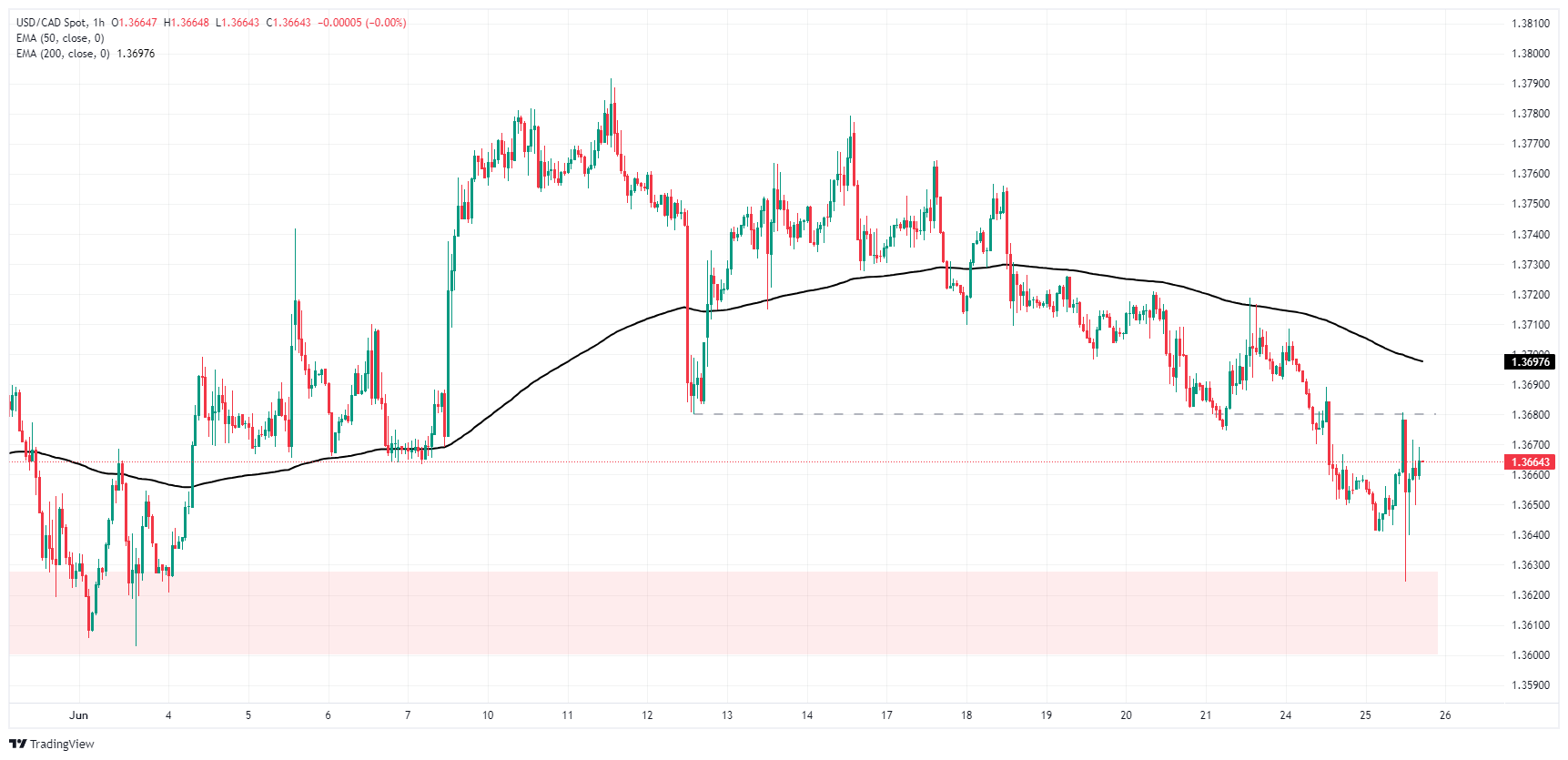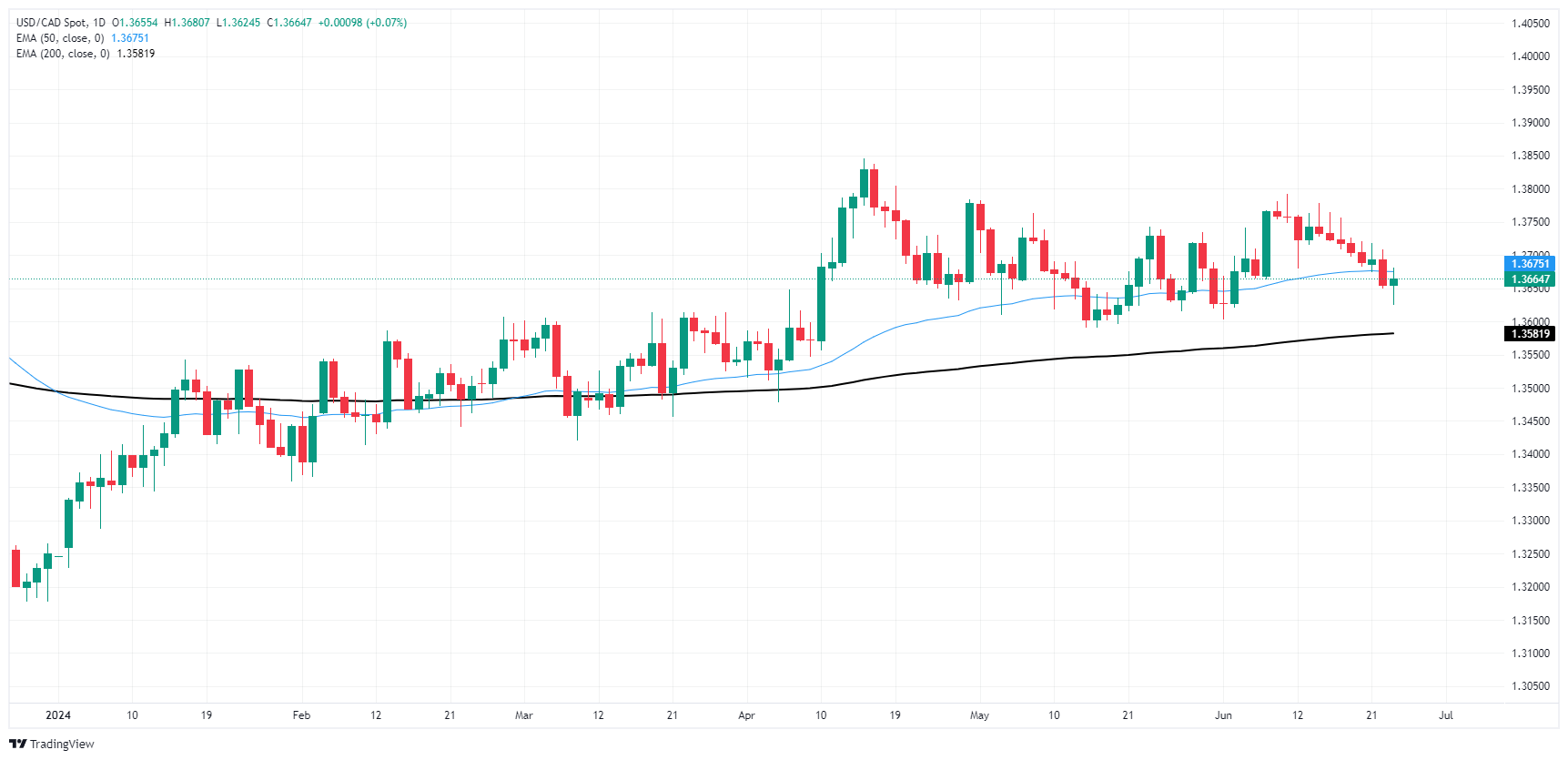- Canadian Dollar whipsaws against Greenback on CPI Tuesday.
- Canada reported an upswing in CPI inflation in May.
- Additional focus to fall on July inflation print in the runup to BoC July rate call.
The Canadian Dollar climbed on Tuesday after Canadian Consumer Price Index (CPI) inflation ticked higher in May. Despite the upswing in CPI growth, the CAD whipsawed against the US Dollar during the American market session, setting a fresh 14-day high before settling back to flat on Tuesday.
Canada also printed an upward surge in the Bank of Canada’s (BoC) CPI Core reading in May. With CPI inflation snapping higher following the BoC’s recent rate cut, renewed focus will be put on June’s upcoming CPI print ahead of the Canadian central bank’s rate call slated for July 24.
Daily digest market movers: Canadian CPI upswing sends CAD higher
- Canadian CPI inflation rose to 2.9% YoY in May, erasing the forecasted downtick to 2.6% from the previous 2.7%.
- MoM CPI climbed to 0.6% in May, coming in well above the forecast 0.3% and accelerating from the previous 0.5%.
- BoC’s own CPI Core also rose to 0.6% MoM versus the forecast hold at 0.2%.
- A snap rise in Canadian inflation follows a recent quarter-point cut from the BoC, which could spark concerns that the Canadian central bank started cutting too early.
- US CB Consumer Confidence survey eased to 100.4 from 102.0, a slightly better print than the expected 100.0.
Canadian Dollar PRICE Today
The table below shows the percentage change of Canadian Dollar (CAD) against listed major currencies today. Canadian Dollar was the strongest against the Euro.
| USD | EUR | GBP | JPY | CAD | AUD | NZD | CHF | |
|---|---|---|---|---|---|---|---|---|
| USD | 0.20% | -0.01% | 0.03% | 0.02% | 0.17% | 0.02% | 0.19% | |
| EUR | -0.20% | -0.21% | -0.17% | -0.19% | -0.04% | -0.12% | -0.02% | |
| GBP | 0.00% | 0.21% | 0.04% | 0.02% | 0.18% | 0.10% | 0.21% | |
| JPY | -0.03% | 0.17% | -0.04% | -0.02% | 0.15% | 0.11% | 0.18% | |
| CAD | -0.02% | 0.19% | -0.02% | 0.02% | 0.14% | 0.07% | 0.19% | |
| AUD | -0.17% | 0.04% | -0.18% | -0.15% | -0.14% | -0.08% | 0.04% | |
| NZD | -0.02% | 0.12% | -0.10% | -0.11% | -0.07% | 0.08% | 0.11% | |
| CHF | -0.19% | 0.02% | -0.21% | -0.18% | -0.19% | -0.04% | -0.11% |
The heat map shows percentage changes of major currencies against each other. The base currency is picked from the left column, while the quote currency is picked from the top row. For example, if you pick the Canadian Dollar from the left column and move along the horizontal line to the US Dollar, the percentage change displayed in the box will represent CAD (base)/USD (quote).
Technical analysis: Canadian Dollar gains some ground amid churn, but gains remain tepid
The Canadian Dollar (CAD) briefly rose to a fresh two-week high against the US Dollar on Tuesday before falling back within the day’s opening range. The CAD also eked out gains against the Euro and the Australian Dollar, climbing around one-fifth of one percent against each.
USD/CAD tumbled to a new 14-day low of 1.3624 before snapping back to Tuesday’s opening bids near 1.3660. The pair is caught in near-term chart churn as bidders struggle to break through intraday technical resistance at 1.3680.
Despite grinding out a -1.2% decline top-to-bottom from early June’s peak at 1.3791, the CAD looks set to run out of gas against the US Dollar with USD/CAD finding a price floor near 1.3650. Daily candles continue to tread water in a consolidation pattern north of the 200-day Exponential Moving Average (EMA) at 1.3582.
USD/CAD hourly chart
USD/CAD daily chart
Canadian Dollar FAQs
The key factors driving the Canadian Dollar (CAD) are the level of interest rates set by the Bank of Canada (BoC), the price of Oil, Canada’s largest export, the health of its economy, inflation and the Trade Balance, which is the difference between the value of Canada’s exports versus its imports. Other factors include market sentiment – whether investors are taking on more risky assets (risk-on) or seeking safe-havens (risk-off) – with risk-on being CAD-positive. As its largest trading partner, the health of the US economy is also a key factor influencing the Canadian Dollar.
The Bank of Canada (BoC) has a significant influence on the Canadian Dollar by setting the level of interest rates that banks can lend to one another. This influences the level of interest rates for everyone. The main goal of the BoC is to maintain inflation at 1-3% by adjusting interest rates up or down. Relatively higher interest rates tend to be positive for the CAD. The Bank of Canada can also use quantitative easing and tightening to influence credit conditions, with the former CAD-negative and the latter CAD-positive.
The price of Oil is a key factor impacting the value of the Canadian Dollar. Petroleum is Canada’s biggest export, so Oil price tends to have an immediate impact on the CAD value. Generally, if Oil price rises CAD also goes up, as aggregate demand for the currency increases. The opposite is the case if the price of Oil falls. Higher Oil prices also tend to result in a greater likelihood of a positive Trade Balance, which is also supportive of the CAD.
While inflation had always traditionally been thought of as a negative factor for a currency since it lowers the value of money, the opposite has actually been the case in modern times with the relaxation of cross-border capital controls. Higher inflation tends to lead central banks to put up interest rates which attracts more capital inflows from global investors seeking a lucrative place to keep their money. This increases demand for the local currency, which in Canada’s case is the Canadian Dollar.
Macroeconomic data releases gauge the health of the economy and can have an impact on the Canadian Dollar. Indicators such as GDP, Manufacturing and Services PMIs, employment, and consumer sentiment surveys can all influence the direction of the CAD. A strong economy is good for the Canadian Dollar. Not only does it attract more foreign investment but it may encourage the Bank of Canada to put up interest rates, leading to a stronger currency. If economic data is weak, however, the CAD is likely to fall.
Information on these pages contains forward-looking statements that involve risks and uncertainties. Markets and instruments profiled on this page are for informational purposes only and should not in any way come across as a recommendation to buy or sell in these assets. You should do your own thorough research before making any investment decisions. FXStreet does not in any way guarantee that this information is free from mistakes, errors, or material misstatements. It also does not guarantee that this information is of a timely nature. Investing in Open Markets involves a great deal of risk, including the loss of all or a portion of your investment, as well as emotional distress. All risks, losses and costs associated with investing, including total loss of principal, are your responsibility. The views and opinions expressed in this article are those of the authors and do not necessarily reflect the official policy or position of FXStreet nor its advertisers. The author will not be held responsible for information that is found at the end of links posted on this page.
If not otherwise explicitly mentioned in the body of the article, at the time of writing, the author has no position in any stock mentioned in this article and no business relationship with any company mentioned. The author has not received compensation for writing this article, other than from FXStreet.
FXStreet and the author do not provide personalized recommendations. The author makes no representations as to the accuracy, completeness, or suitability of this information. FXStreet and the author will not be liable for any errors, omissions or any losses, injuries or damages arising from this information and its display or use. Errors and omissions excepted.
The author and FXStreet are not registered investment advisors and nothing in this article is intended to be investment advice.
Recommended content
Editors’ Picks
EUR/USD retreats to 1.0700 area following post-PCE jump

After spiking to a daily high of 1.0720 with the immediate reaction to US PCE inflation data, EUR/USD lost its traction and declined to the 1.0700 area. Investors remain cautious ahead of this weekend's French election and make it difficult for the Euro to gather strength.
GBP/USD stays below 1.2650 after US inflation data

GBP/USD struggles to preserve its bullish momentum and trades below 1.2650 in the American session on Friday. Earlier in the day, the data from the US showed that the annual core PCE inflation declined to 2.6% in May, limiting the USD's upside and helping the pair hold its ground.
Gold keeps its daily gains near $2,330 following US PCE data

Gold prices maintain their constructive bias around $2,330 after US inflation readings gauged by the PCE matched consensus in May and US yields advance slightly across the curve.
BTC struggles around the $62,000 level

Bitcoin price faces pullback resistance at the lower band of the descending wedge around $62,000. Ethereum price finds support at $3,288, the 61.8% Fibonacci retracement level. Ripple price faces resistance at $0.500, its daily resistance level.
French Elections Preview: Euro to suffer after the calm, as specter of extremists, uncertainty rise Premium

The first round of French parliamentary elections is set to trigger high uncertainty. Soothing messages from the far right and far left leave the Euro vulnerable to falls. Calm may return only after the second round of voting on July 7.